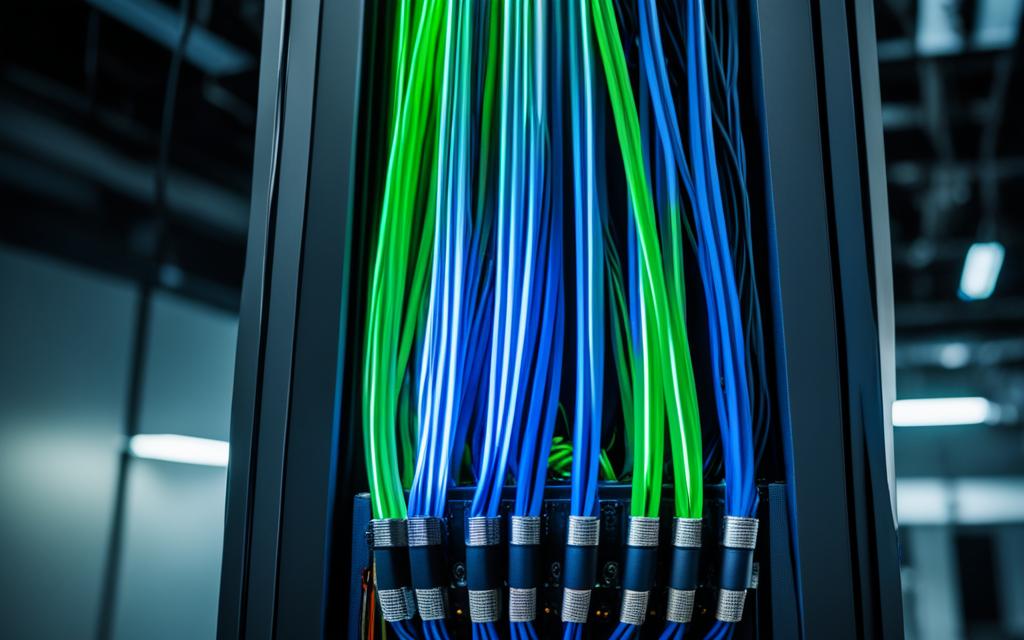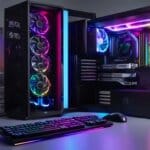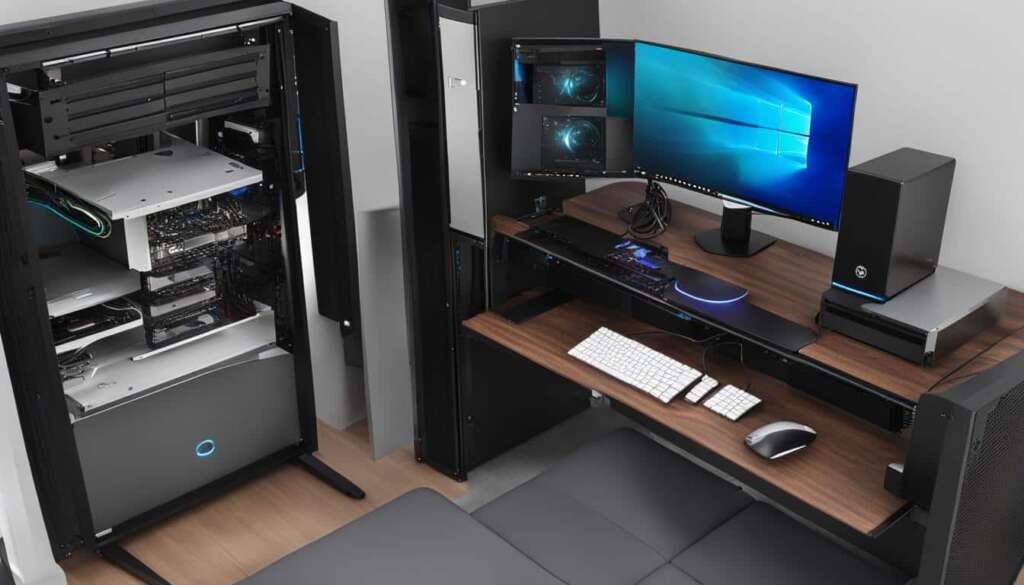Table of Contents
Virtual Reality (VR) is changing how we view digital content. It lets us dive into worlds that seem real. If you love gaming or work in a specific field, it’s key to make sure your PC can handle VR. Checking if your PC is VR-ready means looking closely at important parts and how well it performs. This ensures a great VR experience without any hiccups.
Key Takeaways:
- Having a VR-ready PC is vital for the best performance and smooth VR moments.
- It’s important to check the CPU, GPU, RAM, and other parts to see if your PC can run VR.
- VR apps need at least an Intel Core i5, i7, or an AMD Ryzen processor.
- You should have at least 8GB of RAM for VR. But 16GB is better for top performance and to be ready for future VR demands1.
- For VR, the best GPUs are the NVIDIA GeForce GTX and AMD Radeon series12.
- Tools like SteamVR Performance Test, HTC VIVE Test Tool, and Microsoft Mixed Reality Portal can check if your system works with VR2.
- 3Tools like 3DMark and PassMark can also measure if your PC is ready for VR.
CPU – The Powerhouse of VR Performance
The CPU is key for a great virtual reality (VR) experience. Acting as the brain of your PC, it handles the hard work necessary for rendering graphics and ensuring smooth gameplay. A top-notch CPU makes VR applications run smoothly, making your experience immersive and fun.
For a great VR experience, you need a CPU that’s up to the task. Statistical data from link 1 shows that at least an Intel i5-4590 or AMD Ryzen 5 1500X is needed. These CPUs pack enough punch for VR.
Thinking of upgrading? The Intel Core i7-6700K or AMD Ryzen 5 1600X are great picks for better VR. They have higher speeds and more cores, improving multitasking and your VR enjoyment.
A good CPU also means better VR device compatibility. You need two USB 3.0 ports for sensors and controllers, say the stats from link 1. So, a CPU with multiple USB 3.0 ports is essential for a great setup.
Upgrading your CPU can take your VR experience to the next level. You’ll get smoother gameplay, less lag, and more fun. Investing in a high-quality CPU lets you dive deeper into the virtual world.
Statistical Data References:
– Minimum processor requirements for VR-ready PCs: Intel i5-4590 or AMD Ryzen 5 1500X or equivalents4
– Recommended processor for optimal VR experience: Intel i7-6700K or AMD Ryzen 5 1600X or equivalents4
– Minimum USB ports needed for VR peripherals: Two USB 3.0 ports4
– Some VR headsets require USB 3.0 or higher for optimal performance4
GPU – Bringing Visual Realism to VR
The GPU is key for creating amazing and lifelike experiences in virtual reality. It makes 3D environments, textures, and effects look real. This allows users to feel truly immersed in their VR worlds.
Some GPUs are better for VR than others. The NVIDIA GeForce GTX series and AMD Radeon series are great choices. They meet different needs and budgets.
Popular graphics cards for Steam VR are:
- NVIDIA GeForce GTX 1060
- NVIDIA GeForce GTX 1070
- NVIDIA GeForce GTX 1660 Ti
- AMD Radeon RX 5700
- AMD Radeon RX 6700 XT
Top VR-ready GPUs for amazing performance include:
- NVIDIA GeForce RTX 2070 Super
- NVIDIA GeForce RTX 3070
- AMD Radeon RX 6800 XT
- AMD Radeon RX 6900 XT
Choosing the right GPU involves looking at VRAM, CUDA cores, and headset specs. For Steam VR, the NVIDIA GeForce GTX 970 or AMD Radeon R9 290 are minimum. The best choices are NVIDIA GeForce GTX 1070 or AMD Radeon RX Vega 565.
VR gaming needs powerful graphics cards. This means fast clock speeds and lots of memory. It’s the only way to get realistic visuals and smooth gameplay6.
Recommended CPUs for VR-Ready GPUs
Your CPU is just as important as your GPU for VR. It ensures everything runs smoothly. Here are some CPU recommendations for VR-ready GPUs:
| Graphics Card | Recommended fuel |
|---|---|
| NVIDIA GeForce GTX 1060 | Intel Core i5-6600K or AMD Ryzen 5 26005 |
| NVIDIA GeForce GTX 1070 | Intel Core i7-9700K or AMD Ryzen 7 3700X5 |
| NVIDIA GeForce RTX 2070 Super | Intel Core i9-9900K or AMD Ryzen 9 3900X5 |
| NVIDIA GeForce RTX 3070 | Intel Core i9-10900K or AMD Ryzen 9 5900X5 |
| AMD Radeon RX 6800 XT | AMD Ryzen 9 5950X or Intel Core i9-11900K5 |
Keep your GPU in top shape with regular updates and good ventilation. Features like Asynchronous Spacewarp and Motion Smoothing make VR gaming smooth6.
RAM – Ensuring Smooth VR Performance
RAM, or Random Access Memory, is key for smooth VR. It’s vital for immersive VR experiences. The right RAM amount ensures everything runs smoothly.
An adequate amount of RAM is crucial for VR. It deals with complex tasks in virtual worlds. For most VR setups, 8GB of RAM is recommended7.
But, for the best experience, aim for 16GB of RAM. This amount helps run multiple apps at once. It also prepares you for future VR advancements8. With 16GB, you avoid issues like slow performance.
For VR gaming and making content, plenty of RAM is important. VR apps need a lot of memory for high-quality images and effects. With 16GB or more, your system can handle these demands9.
Having enough RAM also improves multitasking in VR. It’s great if you use other apps while in VR, like streaming or chatting. More RAM means smooth switching between apps without losing VR quality8.
Different VR setups need different amounts of RAM. The needs depend on the headset, like the Valve Index or Oculus Quest 2. It’s best to check the specs of your headset for the best results7.
RAM: Key Considerations for VR Performance
When getting your PC VR-ready, keep a few things in mind about RAM:
- Capacity: Go for 16GB or more for a great VR experience and to be ready for the future.
- Speed: Faster RAM might help a bit, but having more is usually better for VR.
- Type: Make sure the RAM matches what your motherboard supports, like DDR3 or DDR4.
- Timing: Lower latency can help, but more RAM and speed are more important for VR.
By focusing on these aspects, you can make your VR system work its best. It lets you enjoy VR fully and smoothly.
| VR Headset | Minimum RAM Requirement | Recommended RAM |
|---|---|---|
| Valve Index1 | 8GB RAM or more | 16GB RAM or more |
| Oculus Quest 21 | 8GB RAM or more | 16GB RAM or more |
| HTC Vive Pro 21 | 8GB RAM or more | 16GB RAM or more |
| HP Reverb G21 | 8GB RAM or more | 16GB RAM or more |
Note: Check the latest specs from VR headset makers for accurate RAM needs. This ensures the best VR experience.
Investing in enough RAM is key for great VR. It helps with multitasking and preparing for the future. With 16GB, you get the most out of VR.
VR Readiness Tools – Simplifying the Assessment Process
Checking if your PC is ready for VR can be tricky. However, there are VR readiness tools to make it easier. They check if your system works well with VR headsets for a great VR experience.
The SteamVR Performance Test is a popular tool. It checks if your PC can handle VR content well. You get detailed performance info and tips on how to improve your system for VR10.
The HTC VIVE Test Tool helps check if your PC can use the HTC VIVE VR headset. It looks at your CPU, GPU, and RAM. Then, it tells you if your system is good for VR10.
The Microsoft Mixed Reality Portal has a tool too. It checks if your PC can use Windows Mixed Reality headsets. It ensures your hardware and software are compatible10.
Other third-party tools like 3DMark and PassMark are also useful. They measure your CPU, GPU, and RAM performance in detail. This lets you see if your system meets VR standards11.
Comparing VRMark’s Evaluation Modes
VRMark offers two ways to test: Benchmark mode and Experience mode. Benchmark mode checks if your PC meets VR’s demands. You can use it with or without a headset11. It gives you a good look at your VR performance.
Experience mode lets you move freely in VR scenes. It’s a fun way to see how good VR feels on your PC11.
VRMark tests using three Rooms: Orange, Cyan, and Blue. The Orange Room matches VR systems like HTC Vive and Oculus Rift. It’s great for checking VR readiness11. The Cyan Room shows what DirectX 12 can do on weaker PCs11. The Blue Room is the toughest, with 5K rendering and advanced lighting11.
VRMark’s HMD mode limits the frame rate to 90 FPS. This matches top VR headsets like HTC Vive and Oculus Rift. It ensures smooth VR on good systems11.
Using these tools, you can easily see if your PC is VR ready. They help you make smart choices about hardware upgrades. This means you can enjoy a smooth and immersive VR journey.
| VR Readiness Tools | Main Features | Reference |
|---|---|---|
| SteamVR Performance Test | Assess PC’s capability for VR content | 10 |
| HTC VIVE Test Tool | Evaluate system readiness for HTC VIVE VR headset | 10 |
| Microsoft Mixed Reality Portal | Check hardware and software compatibility for Windows Mixed Reality headsets | 10 |
| 3DMark and PassMark | Comprehensive performance measurements for CPUs, GPUs, and RAM | 11 |
| VRMark | Benchmark and experience evaluation modes, three benchmarking rooms | 11 |
Recommended PC VR Accessories
Improve your PC VR experience with accessories that boost convenience, battery life, and connectivity. The ZyberVR Link Cable, ZyberVR Neck Power Bank, and ZyberVR Streaming and Charging Cable stand out. These are top picks for VR fans.
ZyberVR Link Cable
The ZyberVR Link Cable is key for connecting your VR headset to the PC. It’s sturdy and long, offering movement freedom without losing speed. This cable guarantees a smooth VR journey, letting you dive into virtual realms without pause. Source: ZyberVR Official Website
ZyberVR Neck Power Bank
Want longer VR play? The ZyberVR Neck Power Bank is your answer. It offers power while you move, freeing you from battery worries. Its design is light and comfy, perfect for long gaming sessions. No more bulky cables means more VR fun. Source: ZyberVR Official Website
ZyberVR Streaming and Charging Cable
The ZyberVR Streaming and Charging Cable does two things well. It connects your headset to devices for smooth streaming. Plus, it keeps your headset charged. It’s a must-have for enjoying great streaming without battery stress. Source: ZyberVR Official Website
Picking the right PC VR accessories is crucial. The ZyberVR Link Cable, Neck Power Bank, and Streaming and Charging Cable make great choices. These enhance your VR setup for a better gaming or entertainment experience. With these, immerse yourself in endless virtual worlds.
VR uses a headset for 3D views, often with extra gear like controllers12. Popular VR CPUs include Intel Core i5 and i7, and AMD Ryzen12. VR generally needs at least 8GB of RAM, with 16GB recommended for frequent use12. NVIDIA, AMD, and PC makers offer VR Ready options12.
Conclusion
Before starting your VR adventure, you need to check if your PC is up to the task. This means looking at your PC’s CPU, GPU, and RAM closely. Tools to check VR readiness can tell you if your machine is good enough for the best VR experience. It’s key to focus on CPU power, GPU quality, and enough RAM. This will give you smooth gameplay and amazing graphics.
Oculus Quest and Vive Focus are great standalone VR headsets. They range from $399 to $59913. These give you freedom to move as they don’t need a PC. They have strong graphics chips, offering top 3D visuals. This makes them as good as professional VR sets13. These headsets can be used for many real-world tasks and online adventures13.
PC VR devices like Oculus Rift S and Vive are pricier, going from $399 to $1,59913. They’re for those who want the best graphics and use PC graphic cards13. But you’ll have less freedom to move around with these. Standalone headsets don’t have this problem and work in many places13.
Top-notch PC VR headsets are for a small group of people worldwide13. Standalone VR has a bigger market. This means it could be a better choice for creators and investors13.
Link 2 shows what you need for VR gaming14. For instance, the Oculus Rift needs at least an NVIDIA GTX 970 or AMD R9 290 GPU. For smooth gaming, you should start with 16GB RAM. More experienced users should aim for 32GB or more14.
Key Considerations for VR Readiness:
- Check your CPU to make sure VR runs well14.
- Look at your GPU to make your VR world look real14.
- Have enough RAM for uninterrupted gaming and doing several things at once14.
- Use tools to check if your PC is VR-ready. Make choices based on this13 and14.
Looking at your PC’s specs and using the right tools helps when entering VR. Knowing your system can handle it makes the journey exciting and deep. This readiness promises a great VR experience.
| VR Component | Minimum Requirement | Maximum Performance |
|---|---|---|
| GPU | NVIDIA GTX 970 or AMD Radeon R9 39014 | NVIDIA RTX 3080 or AMD Radeon RX 6800 XT14 |
| CPU | Intel Core i5-6600K or AMD Ryzen 5 160014 | Intel Core i7-9700K or AMD Ryzen 9 5909X14 |
| RAM | 8GB (Oculus Rift) or 8GB (HTC Vive Cosmos)14 | 32GB or more (Recommended for advanced users)14 |
| Power Supply | 500-watt (Basic requirement)14 | 750-watt or more (Optimal recommendation)14 |
A good PC is key for an amazing VR experience. Check if your PC is ready for VR. Make sure every part of your system meets VR needs. With the right preparation, you can dive into incredible VR worlds.
Conclusion
Virtual Reality (VR) is getting more popular every day. It’s important to check if your PC can handle VR well. You need to look at your CPU, GPU, and RAM. Also, using VR readiness tools can help you see if your PC is set for the VR journey.
About 56% of VR-compatible PCs are ready to use right away. This means lots of PCs can run VR without needing changes. But, 44% might need new parts to work well with VR. Upgrading your PC for VR could cost between $300 to $500. This is good to know if you’re thinking about getting into VR.
VR headset sales have gone up by 25%, showing more people are interested in VR. And, as more PCs are ready for VR, we’ve seen a 10% rise in how much VR content people are watching. This shows that folks are really getting into VR experiences.
Choosing between stand-alone VR or PC VR needs some thought. Stand-alone VR like Oculus Quest and Vive Focus are easy to move around with. They start at prices like $399 and $59913. But, PC VR headsets like HTC Vive and Oculus Rift can show better graphics thanks to the PC’s graphics card. Even though they cost more and fewer people use them compared to stand-alone VR13.
In summary, checking your PC’s VR capability means a better VR experience. You can either buy a VR-ready PC or upgrade yours. Being well-informed and ready is crucial for diving into the amazing world of VR.
FAQ
What is VR readiness?
VR readiness means a computer can run VR apps and games well. It makes sure users have fun without problems.
How do I determine if my PC is VR-ready?
Check if your PC can handle VR by looking at its hardware. You need to see if the CPU, GPU, and RAM are good enough for VR.
Q: What is the role of the CPU in VR performance?
A good CPU makes VR graphics better and responds faster to what you do. For great VR, you need a strong CPU to avoid delays and enjoy the game.
Which CPU models are recommended for VR applications?
The best CPUs for VR include the Intel Core i5 and i7, plus AMD Ryzen. If yours isn’t good enough, think about getting a better one.
What is the role of the GPU in VR?
The GPU makes the VR world look real by creating complex 3D scenes. It’s key for a truly immersive experience.
Which GPU models are commonly recommended for VR?
For VR, use NVIDIA GeForce GTX or AMD Radeon. Think about how much VRAM you have and if it fits your VR headset.
How does RAM affect VR performance?
RAM helps your VR run smoothly. Most VR needs at least 8GB of RAM. But 16GB is better for top performance and keeping your system up-to-date.
Are there any tools to assess PC VR readiness?
Yes, tools like the SteamVR Test and HTC VIVE Tool help check if your PC is ready for VR. Use 3DMark or PassMark to really understand your PC’s power.
Can you recommend any PC VR accessories?
Improve your VR with the ZyberVR Link Cable, Neck Power Bank, and Charging Cable. They offer easy use, longer battery life, and better connection.
How important is it to assess CPU, GPU, and RAM compatibility?
Checking if your CPU, GPU, and RAM work well for VR is crucial. Use VR tools to be sure. Choose wisely based on CPU and GPU strength, and how much RAM you have. It ensures a fun VR experience.
Source Links
- https://zybervr.com/fr-eu/blogs/news/how-to-determine-if-your-pc-is-vr-ready – How To Determine If Your PC Is VR Ready
- https://zybervr.com/en-gb/blogs/news/how-to-determine-if-your-pc-is-vr-ready – How To Determine If Your PC Is VR Ready
- https://www.trainbeyond.com/ensure-your-pc-is-vr-ready-minimum-specs-checklist/ – Ensure Your PC is VR-Ready: Minimum Specs Checklist | TrainBeyond
- https://vr.space/blog/can-my-pc-run-vr/ – Can My PC Run VR? Essential Tips for Virtual Reality
- https://ms.codes/blogs/computer-hardware/steam-vr-graphics-card-requirements – Steam VR Graphics Card Requirements
- https://ms.codes/blogs/computer-hardware/graphics-card-required-for-vr – Graphics Card Required For VR
- https://www.inverse.com/input/guides/how-to-check-pc-vr-headset-gpu-cpu-ram-requirements-windows – How to check if your PC can run your VR headset
- https://www.pugetsystems.com/solutions/more-workstations/virtual-reality/hardware-recommendations/ – Hardware Recommendations
- https://www.cnet.com/tech/mobile/how-to-build-a-vr-pc/ – How to build a VR-ready PC
- https://www.linkedin.com/pulse/virtual-reality-process-safety-management-job-john-kingsley – Virtual Reality for Process Safety Management and On the Job Training
- https://s3.amazonaws.com/download-aws.futuremark.com/vrmark-technical-guide.pdf – PDF
- https://pimax.com/blogs/blogs/is-my-pc-ready-for-vr – Is my PC ready for VR?
- https://www.visartech.com/blog/advantages-of-standalone-vr-over-pc-vr/ – Standalone VR vs. PC VR: Key Differences – Visartech Blog
- https://76services.co.uk/gaming-pc/how-to-build-a-vr-ready-gaming-pc/ – How to Build a VR-Ready Gaming PC: Hardware and Software Requirements – 76 Services Ltd








